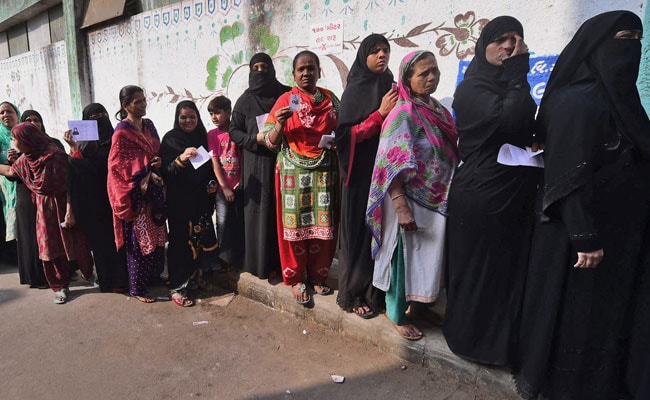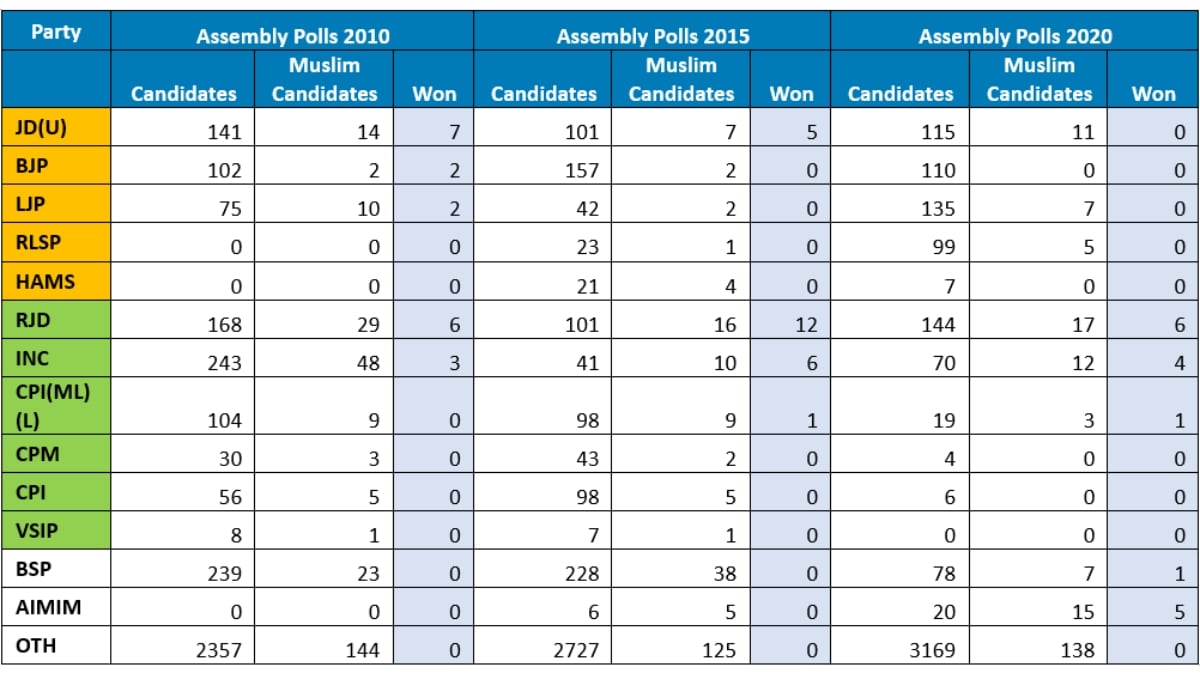
- Asaduddin Owaisi's AIMIM to contest 32 seats in Bihar focusing on Muslim-majority regions
- Tejashwi Yadav remains confident as AIMIM influence is limited to Muslim-majority areas
- Mahagathbandhan alleges AIMIM acts as BJP's B-team to divide Muslim vote in Bihar
In the colourful mosaic of Bihar's political landscape, where the holy Ganges and its tributaries flow with a history of resilience and renewal, and where democratic competition for votes has brought about a social churn among castes and communities - like the recurrent waves and floods of the Gangetic ecosystem - the question of representation has taken on a new urgency.
Asaduddin Owaisi's All India Majlis-e-Ittehadul Muslimeen (AIMIM) has emerged as a provocative voice in this complex narrative, raising pointed questions about the Mahagathbandhan's decision not to announce a Muslim deputy chief ministerial candidate.
Given that Muslims constitute nearly 18 per cent of Bihar's electorate, the absence of a representative in such a pivotal role is a paradox that reverberates through the state's socio-political discourse.
Landscape Of Votes And Voices
As the Majlis enters the electoral fray with candidates in 32 constituencies, particularly in the north Bihar regions of Seemanchal and Mithilanchal, its significance cannot be understated. These areas, rich in cultural diversity and marked by a substantial Muslim presence, provide fertile ground for Owaisi's ambitions. The AIMIM's previous success - winning five seats in the 2020 Bihar assembly elections in Seemanchal - suggests a burgeoning influence that the Mahagathbandhan cannot afford to overlook.
Yet, the choice to announce Mukesh Sahani, a leader representing the Nishad-Mallah-Sahani vote, as deputy chief ministerial candidate - despite his community's claimed 9 per cent of the electorate - raises critical questions. Why, in a state where Muslims are a significant demographic, would a coalition that aims to be inclusive overlook their representation at such a high level? The irony is palpable: a party claiming to represent a minority community has opted for a candidate from a numerically smaller group, thereby raising the stakes in an already charged political atmosphere.

Dividing Muslim Vote Or Putting Pressure On Mahagathbandhan?
By articulating what seems to be an exclusionary oversight, the AIMIM is not merely playing the role of a discontented observer; it is actively engaging in a strategic manoeuvre that reflects a deeper political calculus. Is the AIMIM attempting to carve out a niche for itself among Muslim voters, perhaps to fracture the unity of the 18 per cent Muslim vote and siphon support from the Mahagathbandhan? This could be seen as an opportunistic play, leveraging the discontent of a community that feels marginalised even within a coalition that ostensibly champions secular values.
Alternatively, Owaisi's critique could be interpreted as a calculated effort to apply pressure on the Mahagathbandhan, forcing it to reckon with its own shortcomings in representation. By highlighting the absence of a Muslim deputy chief minister candidate, the AIMIM is challenging the coalition to confront its narrative of inclusivity and to reflect on the aspirations of the very community that has historically aligned with secular parties - the Congress and the Rashtriya Janata Dal (RJD) in Bihar.
Why Is Tejashwi Yadav Unfazed Despite AIMIM Challenge?
In the tumultuous waters of Bihar politics, where alliances shift like the Ganges and electoral fortunes can change with the turn of a season, Tejashwi Yadav stands unfazed by the encroaching presence of the AIMIM, which has set its sights on 32 constituencies in north Bihar, particularly in the Seemanchal and Mithilanchal regions.
Yadav's composure hints at a deeper understanding of the electoral landscape - one shaped by past experiences and grounded in the nuances of voter behaviour.
To grasp Yadav's apparent nonchalance, we must first recognise the context of AIMIM's previous successes. In the 2020 assembly elections, the party secured five seats out of its twenty contested, a commendable feat that might have sent tremors through many political camps. Yet, in a twist of political irony, four of those victorious MLAs crossed the aisle to join the RJD after the polls concluded. This phenomenon, where erstwhile rivals embrace the RJD's umbrella, suggests a fluidity in allegiance that undermines AIMIM's standing as a formidable challenger. It speaks volumes about the party's inability to maintain its gains in the long term, a reality that Yadav seems to appreciate.

Moreover, the geographical and demographic dynamics of AIMIM's victories reveal a complex narrative. The five assembly seats won by the AIMIM were situated in Seemanchal, where Muslim voters constitute a formidable majority, often exceeding 60 per cent. In such polarised environments, the electoral battleground transforms into a binary choice - Muslim candidates versus non-Muslim ones. Here, the AIMIM capitalised on a stark polarisation, with the BJP emerging as the runner-up in four out of the five contests. This pattern underscores a crucial point: the AIMIM's victories were not a direct affront to the RJD or the Mahagathbandhan but rather a reflection of localised dynamics where Muslim voters rallied behind a party that seemed to represent their interests most effectively.
Decoding AIMIM Challenge: Harry Blair's Hypothesis
Tejashwi Yadav's strategic insight aligns with the observations of American election analyst Harry Blair in his magnum opus, Minority Electoral Politics in a North Indian State: Aggregate Data Analysis and the Muslim Community in Bihar.
Blair posited that minority voting behaviour is significantly influenced by the demographics of the electorate. According to Blair, when Muslims constitute a majority, they are more inclined to support Muslim candidates or parties. However, in constituencies where they are outnumbered, the inclination shifts towards secular parties or coalitions led by Hindus. This thesis finds resonance in the current Bihar political scenario, as the AIMIM's influence appears to thrive only in those few strongholds where Muslim voters dominate.
In Jokihat, the sole seat where the RJD was the runner-up, the dynamics were more favourable for the Mahagathbandhan, illustrating that AIMIM's reach is limited and contextually specific.

Thus, as Tejashwi Yadav contemplates the AIMIM's challenge, he does so from a position of strategic clarity. The RJD's historical alliance with Muslim voters, combined with its broader coalition-building efforts, provides a sturdy foundation that is not easily shaken. The AIMIM's presence, while significant in certain regions, does not pose an existential threat to the Mahagathbandhan. Instead, it serves as a reminder of the necessity for adaptability and awareness in a political landscape defined by shifting allegiances and evolving voter sentiments.
In essence, Yadav's calm in the face of Owaisi's ambitions reflects a profound understanding of both history and demographics. Rather than viewing the AIMIM as a competitor, he recognises it as a phenomenon rooted in specific electoral conditions, one that ultimately reinforces rather than undermines his coalition's standing. This perspective, steeped in political acumen, allows Yadav to navigate the complexities of Bihar politics with a steady hand, poised to embrace the challenges while remaining anchored in the enduring support of his base.
Mahagathbandhan's Swipe At AIMIM As BJP's B-Team
The political landscape is rarely black and white. Within the murky waters of Bihar's electoral politics, accusations abound that AIMIM is functioning as a "B-team" of the BJP. This assertion, often echoed by Mahagathbandhan leaders, suggests a strategic alliance of sorts, where the polarisation between the Hindu majority and the Muslim minority serves both the BJP's agenda and the AIMIM's ambitions. The logic follows that a divided Muslim vote weakens the secular front, ultimately benefiting the BJP, which thrives on narratives of majoritarianism. In these five constituencies, the majority is the Muslim population, the minority is the Hindu population as in Kashmir valley.

This perspective invites us to ponder the broader implications of AIMIM's entry into Bihar's political arena. By engaging in the discourse around representation, the party not only seeks to assert its own relevance but also inadvertently contributes to the polarisation that many fear will erode the secular fabric of the state.
Political Ripples Across Ganges
As the political currents swirl ahead of the 2025 elections, the questions raised by the AIMIM resonate like ripples across the Ganges. The agenda of illegal immigration from Bangladesh and Myanmar has been replaced by the issue of unfair and underrepresentation of minorities, and challenges of polarisation take a new direction. The paradox of representation, where a significant community feels sidelined despite its electoral weight, highlights the complexities inherent in coalition politics. Whether the AIMIM is genuinely seeking to empower Muslims, testing the Mahagathbandhan's resolve, or playing a role that aligns with the BJP's interests, its presence is a reminder of the intricate dance of identity, power, and representation in Bihar.

In this culturally rich and socially tumultuous landscape, where the monsoon rains nourish both the land and its people, the stakes are very high. The choices made in these coming elections will not only shape the political future of Bihar but also redefine the narratives of community and representation that have long influenced its history. As the electoral tide rises, it remains to be seen whether the voices of Bihar's diverse communities will find their proper place in the chorus of governance or whether they will be swept away in the currents of political ambition and community polarisation.
Track Latest News Live on NDTV.com and get news updates from India and around the world

